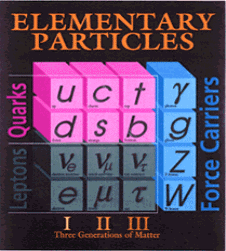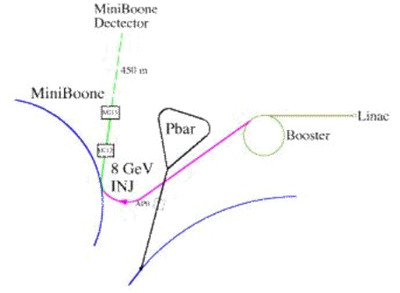Friday October 10 through Monday October 13
All shifts began in shutdown.
On Friday morning, technicians repaired the Booster magnet with the LCW leak discovered on Thursday evening. Water techs valved in the LCW system for the new correction magnets recently installed in the MI-8 line.
On Saturday morning, ComEd shut off power to feeder 24 for maintenance work as scheduled; power was out for about eight hours.
On Monday morning, ComEd shut off power to all of Fermilab at 7 AM for about twenty minutes.
MINIBOONE
The MiniBooNE experiment hopes to confirm or refute findings from the Los Alamos National Laboratory in New Mexico, which found muon anti-neutrinos oscillating into electron neutrinos. Why is this important? If neutrinos can oscillate, that means they have mass. The Standard Model currently says that neutrinos have zero mass; particles of equal mass cannot transform into one another. If you start off with muon neutrinos and sometime later detect electron neutrinos, you have to conclude that a transformation has occurred and that at least one of the neutrinos is not massless.
 Neutrinos are subatomic elementary particles in the set of building blocks for the universe. Currently, the theory states that there are three flavors of neutrinos: electron, muon, and tau neutrino. Each flavor also has an anti-neutrino.
Neutrinos are subatomic elementary particles in the set of building blocks for the universe. Currently, the theory states that there are three flavors of neutrinos: electron, muon, and tau neutrino. Each flavor also has an anti-neutrino.
In 1930, Wolfgang Pauli proposed the existence of a neutral particle, but one that did not react strongly enough for it to be detected. In 1933, Enrico Fermi called this particle the neutrino, which meant "little neutral one." In 1956, physicists Reines and Cowan found evidence of neutrino interactions.
Current evidence shows that neutrinos do oscillate, which indicates that neutrinos do have mass. The Los Alamos data revealed a muon anti-neutrino cross over to an electron neutrino. This type of oscillation is difficult to explain using only the three known types of neutrinos. Therefore, there might be a fourth neutrino, which is currently being called a "sterile" neutrino, which interacts more weakly than the other three neutrinos.
If MiniBooNE can confirm these findings, it would have a massive impact on the standard model not to mention the implications for future research in various fields of physics.
MiniBooNE is "mini" because it is the first part of a possible two-part experiment. If MiniBooNE establishes evidence for neutrino oscillations by 2004, it will be upgraded to BooNE (Booster Neutrino Experiment), with the addition of a second detector. Hopefully, BooNE will determine the oscillation parameters and possibly yield further information about the mass of a neutrino.

Accelerator Update Archive
More Information
For Tevatron luminosity charts and the current status of Fermilab's
accelerators and detectors (live!), please go to Fermilab Now
Comments and Suggestions
What do you think about the Accelerator Updates? Please send comments and suggestions to: accelupdates@fnal.gov.

|